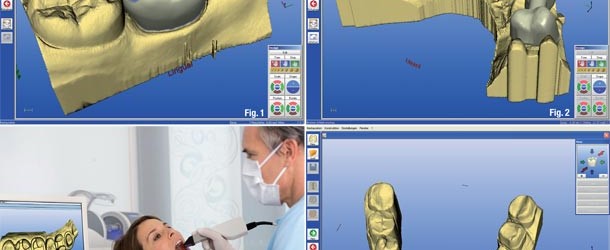When going to the dentist you may realise that in some cases the dentist takes a mould (or an impression) after preparing your teeth for a restoration.
To improve the design and creation of dental restorations (such as crowns, bridges, inlays or veneers), some dental practices may use CAD/CAM systems. By using this technology (you can find more information if you click here), dentists aim to improve the quality of restorations as well as complete a prosthesis in a much shorter time.
CAD/CAM systems are very complex computerized systems, which involve a lot of elements. Generally, a CAD/CAM system contains a 3D scanner, some computers on which the modulated tooth can be visible, an automated dental drill, and a dental vacuum cleaner. This is a very important process, which has a lot of advantages, both for the patient, and for the dentist.
First of all, the patient does not have to spend a lot of time using a temporary crown or a temporary bridge until the designed restoration is ready. Processing time is reduced because the entire procedure is performed by computer systems, and the operator must not be present all the time. In some cases, CAD/CAM systems allow practitioners to provide patients with crowns, inlays, or veneers in a single appointment.
The process has many advantages for the dentist as well. Treatment time is shortened, which gives the practitioner additional time for attending more patients. Besides that, CAD/CAM systems are highly accurate. The systems have a margin of error of less than 20 microns.
However, CAD/CAM restorations are considered less aesthetic than traditional restorations.
The dental technician or the dentist himself must be there to complete the job done by the computer. He must apply the last layers of porcelain, and this must be done effectively and rapidly, by the hands of someone who really knows his job. Basically, the dentist or the technician will have to spend time for the final touches and this will be down to the dentist’s skill and expertise.
Here we can talk about the needs of the beneficiary. The colour and the material, this are things that the technician or the dentist can establish with the patient before desining the restoration. CAD/CAM dentistry means a lot of work is done by “simply clicking” the systems command buttons. This can be a huge help, especially if we consider the amount of work that is involved when fabricating a dental prosthesis.
The only requirement is to have “an operator” who knows the technology and pays attention to details . Beyond that, the procedure is simple, and it does not cost a lot of money (although it is more expensive than traditional dentistry).
Anyone can benefit from it : everyone who believes that his health means something, anyone who understands the importance of having all the teeth in their place. Many dental practitioners believe that CAD/CAM dentistry means the future in the dentist area.


